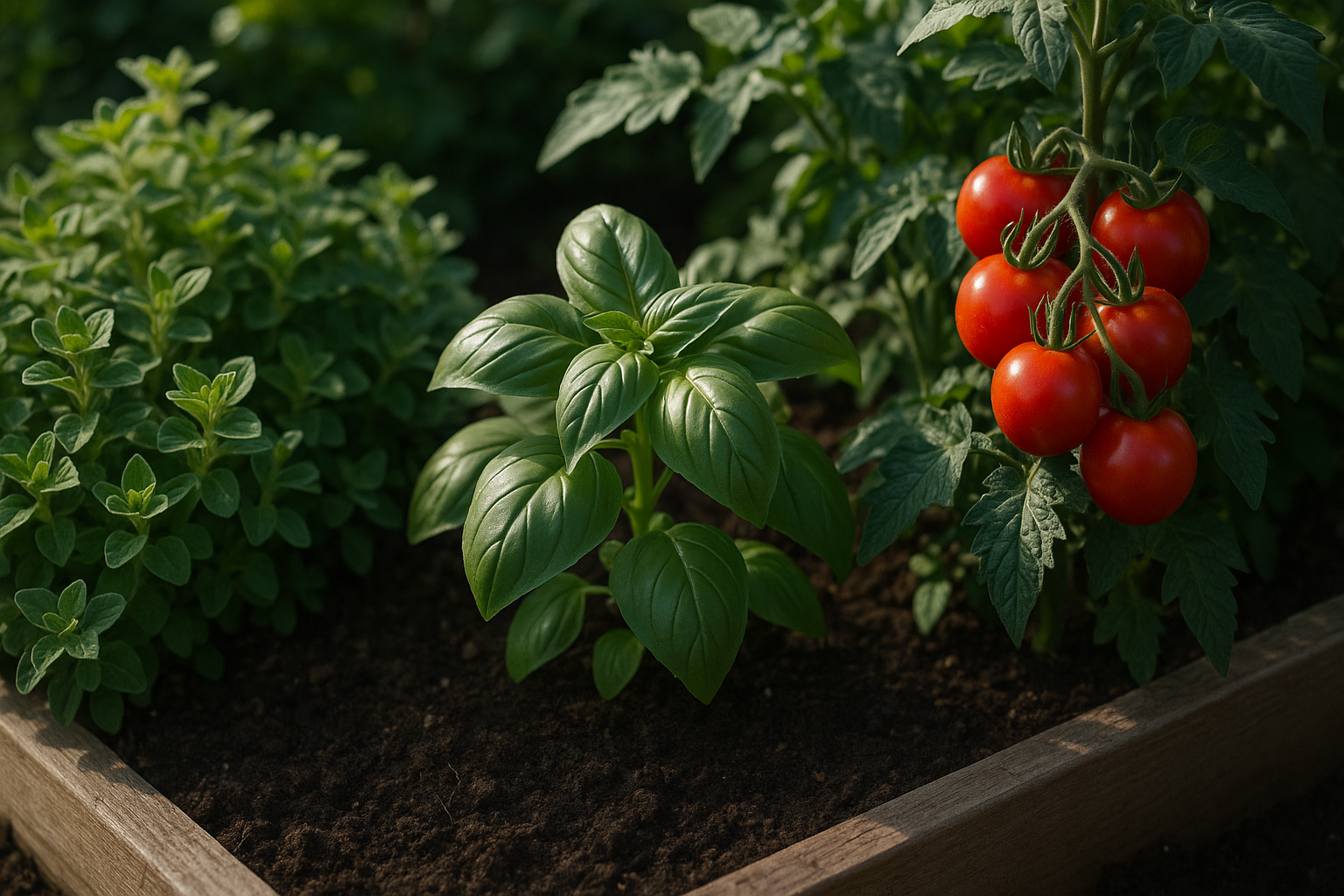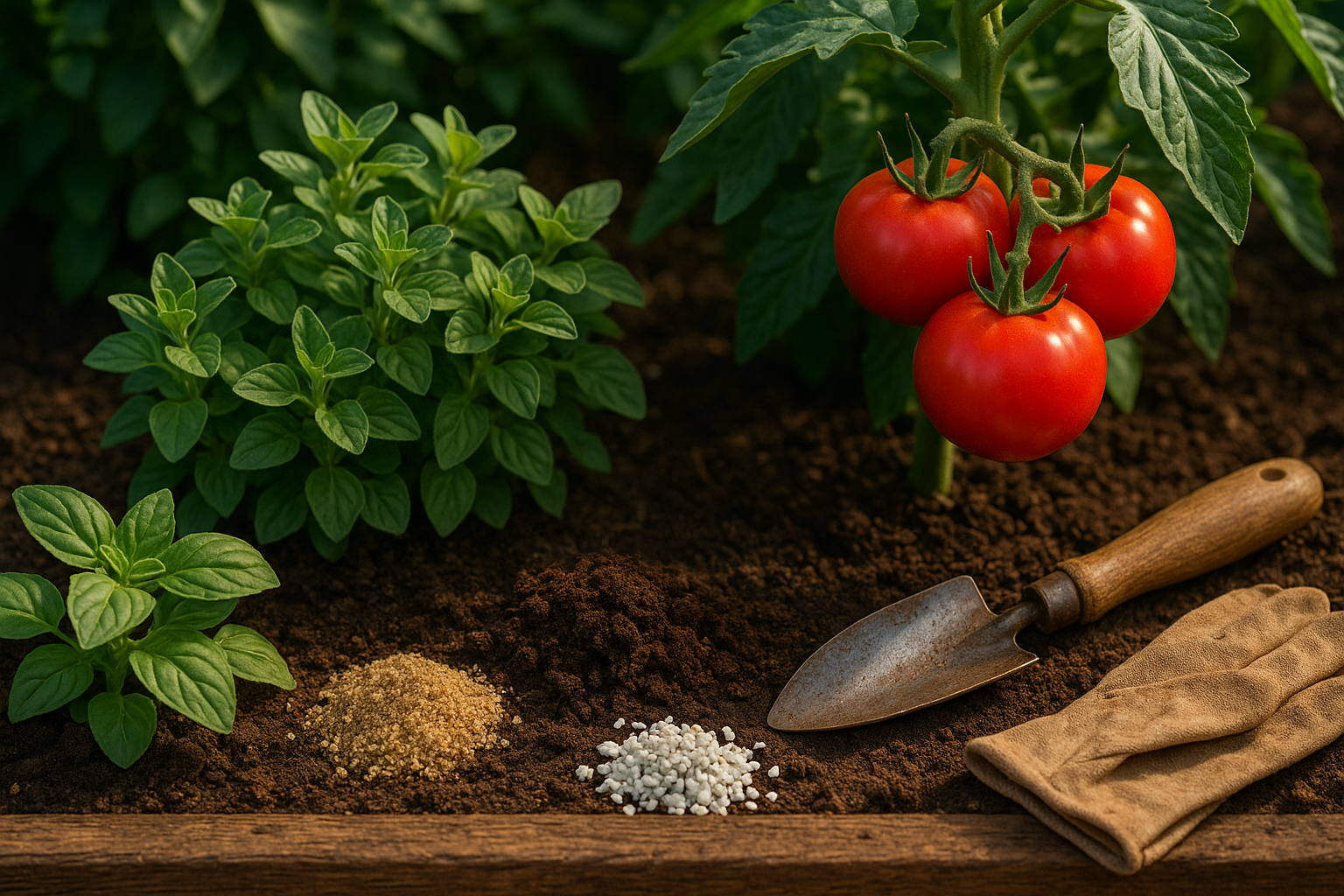What Is Companion Planting?

Companion planting is a simple gardening technique where different plants are grown close together because they help each other thrive. Many home gardeners use this method to boost productivity, reduce the need for chemicals, and create a healthier garden ecosystem.
For example, pairing certain herbs and vegetables can naturally deter pests, improve soil quality, and even enhance the flavors of your crops. Oregano, tomatoes, and basil are classic examples of this synergy.
Tomatoes benefit from being planted near basil, which is known to repel pests like aphids and also boost the flavor of ripening tomatoes. Oregano acts as a living mulch, helping to shade the soil and retain moisture while giving off natural scents that confuse common insect threats.
By growing these three together, you create a mini community where each plant supports the others, leading to bigger harvests and fewer headaches. Even if you’re gardening in small spaces, like patio containers or raised beds, grouping these companion plants lets you make the most of every inch and enjoy fresh, flavorful ingredients right at home.
Benefits of Growing Oregano with Tomatoes or Basil
Pairing oregano with tomatoes or basil in your garden brings a bunch of benefits, both for your plants and your kitchen. Oregano’s strong aroma acts as a natural pest deterrent, helping to repel common troublemakers like aphids and spider mites that often target tomatoes and basil. This reduces the need for chemical pesticides and creates a healthier garden ecosystem.
Many gardeners have noticed stronger, more robust tomato and basil plants when grown alongside oregano. Some research and plenty of garden anecdotes suggest this is due to decreased pest pressure and possibly enhanced soil health from mixed plantings. Plus, oregano, basil, and tomatoes share similar growing needs, so they thrive together and make efficient use of your space—perfect for small plots or containers.
These plant companions also make harvesting for your kitchen super easy; you can gather all the essential ingredients for sauces and salads in just a few steps. Garden-fresh oregano, basil, and tomatoes elevate the flavors of any dish, turning simple recipes into something special. So whether you’re aiming for bigger harvests or tastier meals, combining these classic herbs and veggies offers both practical and delicious results.
Best Practices for Planting Oregano, Tomatoes, and Basil Together

To successfully grow oregano, tomatoes, and basil together, start by choosing a sunny location that receives at least 6-8 hours of direct sunlight daily. These three Mediterranean favorites thrive in similar conditions, so well-draining, nutrient-rich soil with a slightly acidic to neutral pH (6.0–7.0) is ideal.
Begin by preparing your bed or a large container, at least 18 inches deep, with compost-enriched potting mix to give your plants a strong start. Space your tomatoes center stage, with about 18-24 inches between each plant to allow ample root and canopy growth. Plant basil about 12-18 inches from the tomatoes—close enough for beneficial interactions but far enough to prevent crowding. Place oregano at the bed’s edge or at least 10-12 inches from its neighbors, as its sprawling nature makes it ideal as a border herb.
Water thoroughly after planting, then maintain a routine of deep watering 1-2 times per week, allowing the top inch of soil to dry between waterings. This helps prevent root rot and fungal issues, especially around tomato stems. Fertilize every 4-6 weeks with a balanced, organic fertilizer, but avoid excess nitrogen, which can stunt flowering and fruiting.
Keep growth in check by regularly pinching basil tops to encourage bushiness and reduce shading, pruning lower tomato leaves for air circulation, and trimming oregano as needed to control its spread. Use stakes or cages for tomato support to prevent sprawling and optimize airflow for all plants.
Mulching with organic material like straw or shredded leaves helps retain soil moisture, discourage weeds, and keep plant roots cool—just keep mulch a couple of inches away from stems to deter pests.
By following these steps, your combined planting will thrive, offering a steady harvest of tomatoes, fragrant basil, and robust oregano all season long—a delight for both your garden and your kitchen.
Potential Issues and Plants to Avoid
Growing oregano with tomatoes or basil can sometimes create more challenges than benefits. Oregano tends to spread quickly and take over garden spaces, which can crowd out slower-growing herbs like basil. This aggressive growth leads to competition for nutrients, leaving basil or even tomato plants looking stunted or less productive.
Another concern is that oregano’s dense foliage can reduce airflow around neighboring plants, increasing the risk of fungal issues like powdery mildew, especially in the humid conditions common with tomatoes. Some plants simply don’t thrive near oregano; for example, cucumbers struggle because oregano’s strong roots may interfere with their shallow root systems, resulting in poor growth. Similarly, sage is best grown away from oregano due to competition for space and resources.
Troubleshooting Common Problems
To keep your garden thriving, try these tips:
- Regularly thin oregano to prevent overspreading and ensure sunlight reaches all plants.
- Watch for yellowing leaves or slow growth in tomatoes and basil, which may signal nutrient competition—consider adding compost or organic fertilizer to give everyone a boost.
- If you notice signs of fungal disease, such as spots or powdery residue, improve spacing or prune excess oregano branches to boost air circulation.
- For pest troubles like aphids attracted to crowded herb plantings, try a gentle spray of water or introduce beneficial insects such as ladybugs.
Ultimately, a little garden observation and routine maintenance go a long way in balancing oregano’s vigor with the needs of your other plants.
Tips for a Thriving Herb and Vegetable Garden
Maintaining a thriving herb and vegetable garden doesn’t have to be overwhelming if you start simple and build good habits. First, remember the importance of crop rotation: avoid planting the same family of veggies (like tomatoes and peppers) in the same spot year after year. This helps prevent diseases and keeps soil nutrients balanced.
Plan out your bed layouts each season, rotating crops—which is easy to do with a sketch or even a garden planner app.
Succession planting is another trick to ensure a steady supply of fresh produce. For example, after harvesting lettuce, you can pop in fast-growers like radishes or scallions in the same spot.
Mixing up your crops with companion plants can naturally boost your yields. Try planting basil and marigold near tomatoes to deter pests, and add oregano around peppers to help ward off aphids. Don’t be afraid to get creative—swap in calendula, chives, or nasturtium to see which combos work best for you.
Make a weekly habit of walking through your garden, observing leaf color, spotting pests, and checking soil moisture. Early detection allows for prompt, targeted intervention—nip fungal spots or insect infestations in the bud before they spread.
Regular deadheading (removing spent flowers on herbs like basil) encourages more growth, and harvesting early in the morning preserves flavor and freshness.
Most importantly, keep experimenting and taking notes—what worked one year might need tweaking the next. Your garden will thank you with bigger harvests and fewer headaches.
Frequently Asked Questions (FAQs) About Companion Planting Oregano
Can I plant oregano next to tomatoes?
Absolutely—oregano is a fantastic companion for tomatoes. Its aromatic oils can deter common pests like aphids, and alongside tomatoes, it helps create a healthier garden ecosystem.
Will oregano compete with my basil?
Not significantly. Both herbs prefer well-drained soil and full sun, but basil needs a bit more water, so keep an eye on soil moisture. Planting them with a few inches of space allows airflow and prevents overcrowding.
Should I worry about oregano spreading too much?
Oregano can be a vigorous grower, especially in warmer climates. To avoid it taking over, periodically trim the stems or try planting it in containers sunk into the ground.
Does oregano change the flavor of nearby tomatoes or basil?
No need to worry—while oregano’s scent can enhance your garden’s aroma, it won’t change the flavor profile of neighboring plants. Instead, you may notice healthier tomatoes and basil thanks to oregano’s pest-repelling properties.
With a little planning, oregano thrives alongside these favorites, supporting a vibrant and productive vegetable patch.
